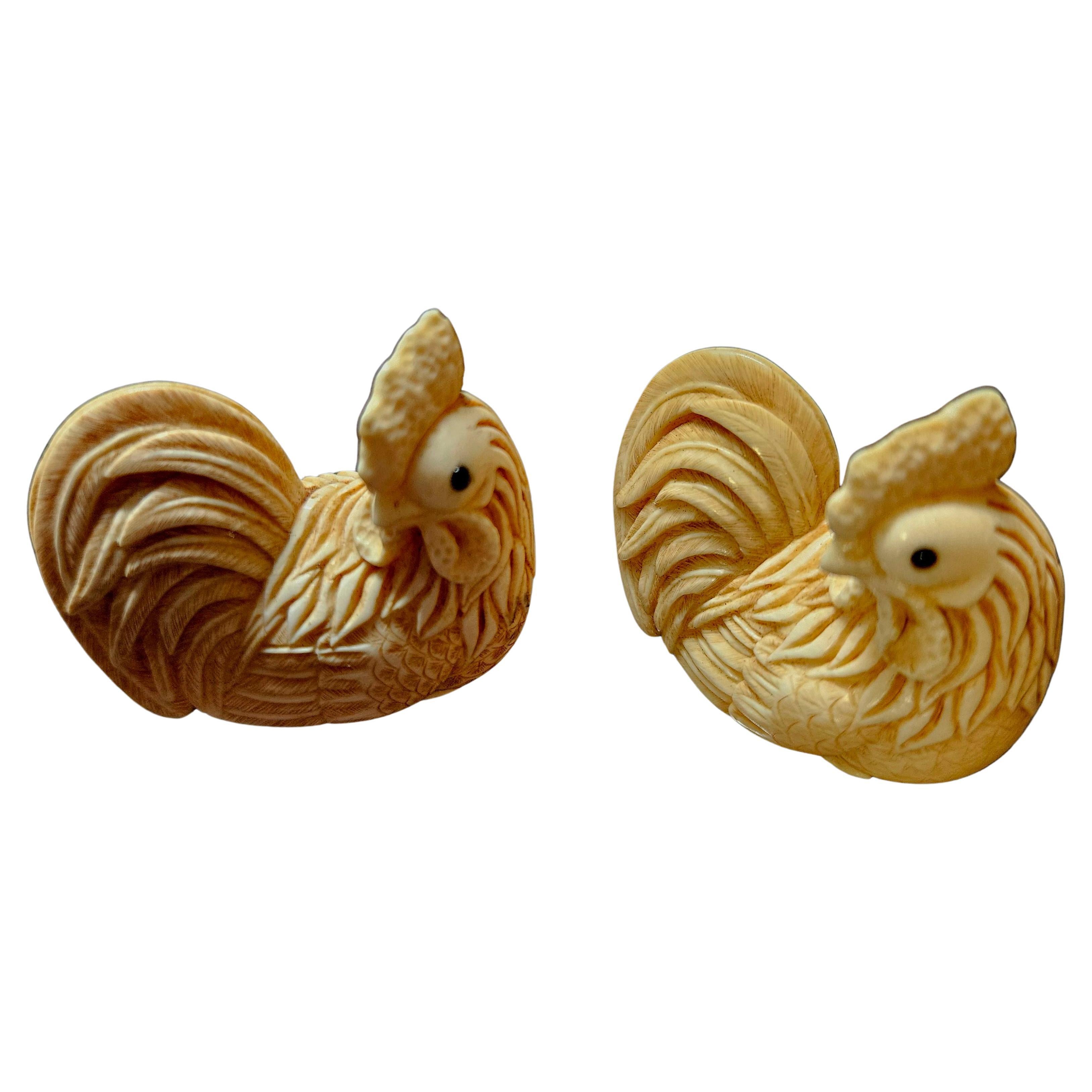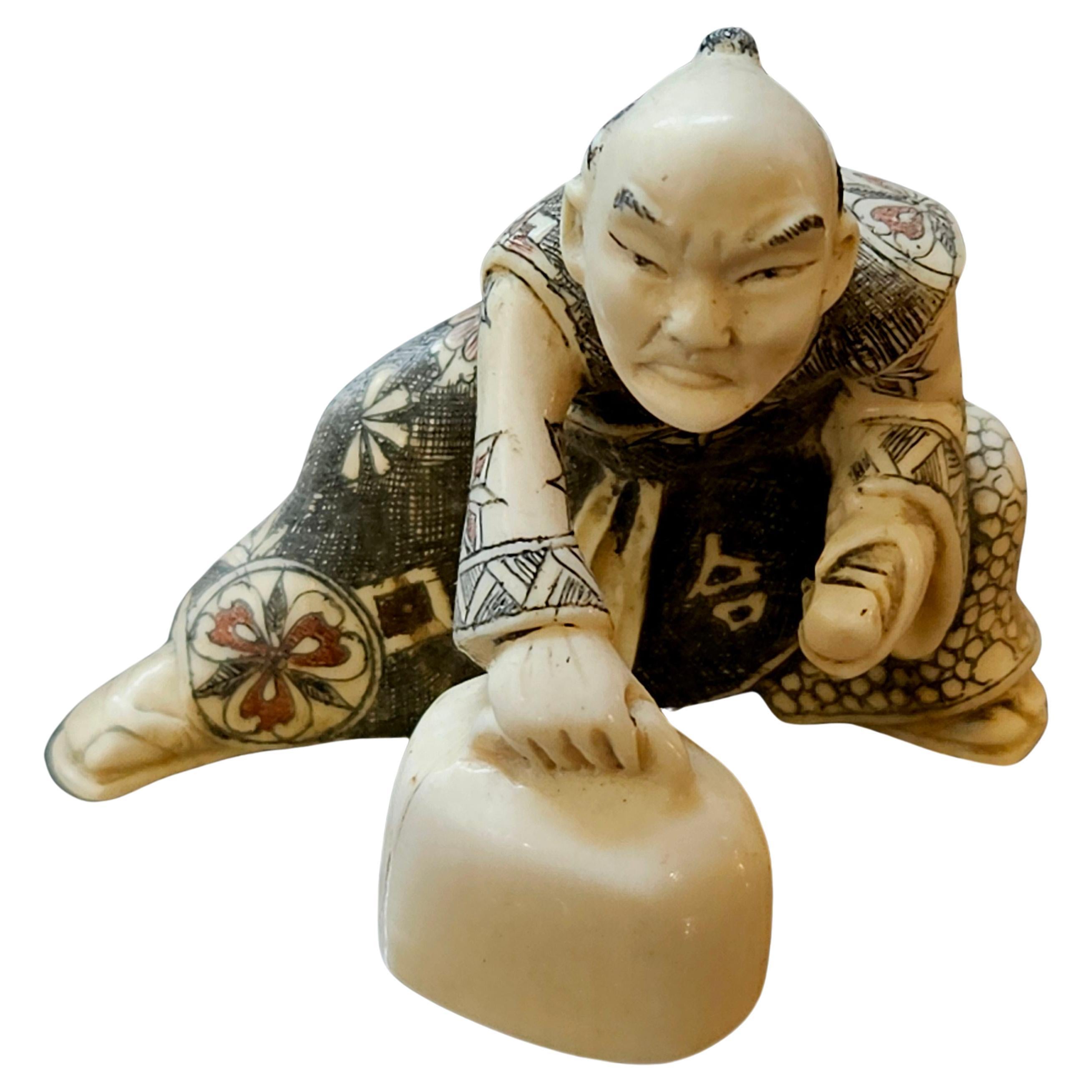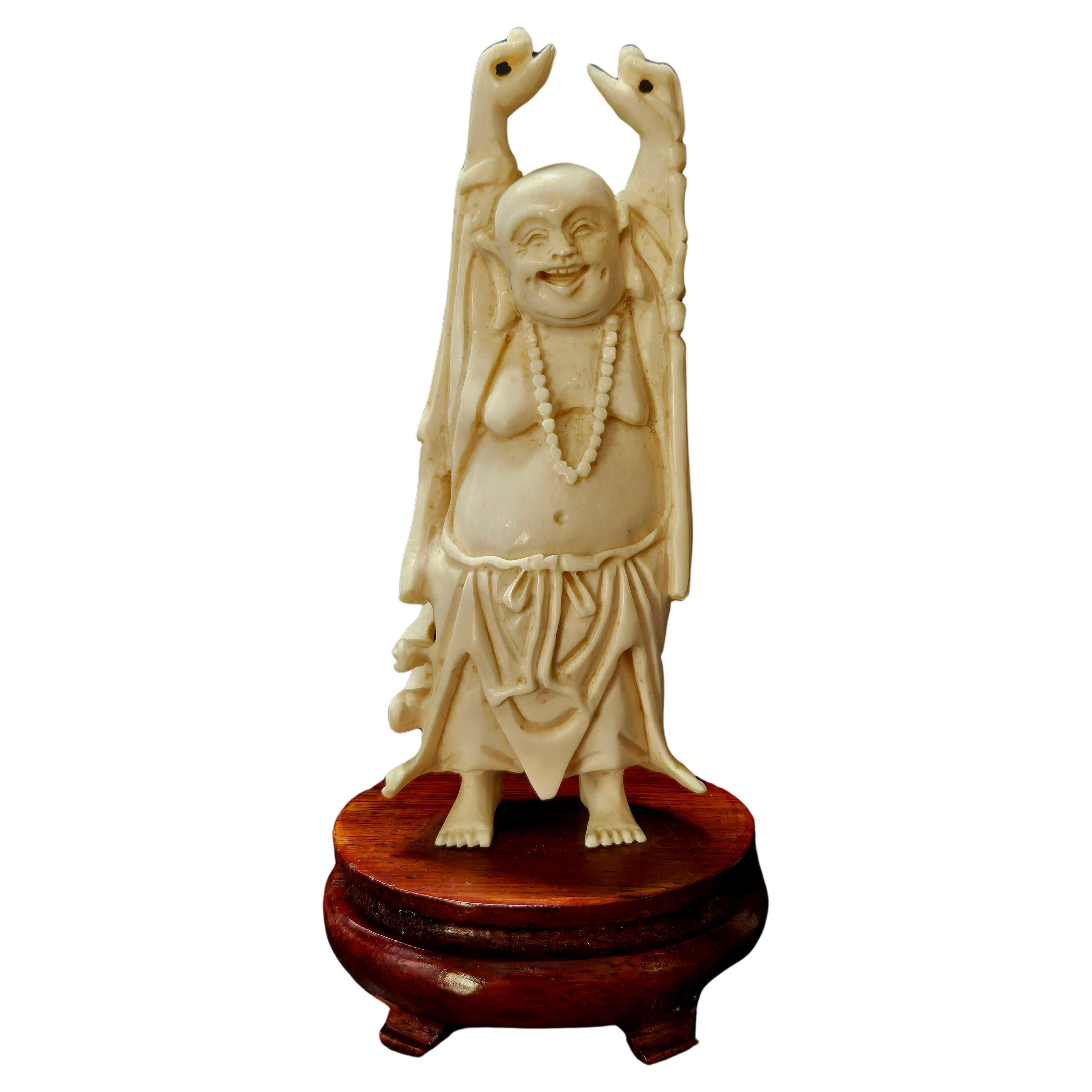Items Similar to Antique Pair of Japanese Carved Netsukes "Dragon Turtles", Meiji Period
Want more images or videos?
Request additional images or videos from the seller
Antique Pair of Japanese Carved Netsukes "Dragon Turtles", Meiji Period
About the Item
Antique Pair of Japanese Carved Netsukes "Dragon Turtles", depicting two turtles with turtle bodies but dragon heads.
This item is 1.35" wide x 1.75" deep x 1" high in dimension, from the late 19th century with wonderful carving.
This item is in excellent condition with no damages.
Shipping Note: USA only, no International shipping
The Essence of Netsuke:
Like all art objects of great worth, netsuke distills the essence of a specific time and place. Worn as part of a traditional Japanese man’s ensemble from the 17th century onwards, the netsuke’s purpose was hyper-specific, and its functional simplicity lent artists unlimited freedom to constantly redefine what it could be.
Formally, netsukes have few requirements: they must be small, they must have holes through which to pass a single cord, and they must have no protuberances that could damage one’s kimono. Everything else is left to the carver’s imagination. As such netsuke differs in style, subject, and material as widely as the personalities of their makers, and they are consequently supremely collectible.
Netsuke emerged as a practical solution to dressing in 17th-century Japan. ‘Men’s kimonos didn’t have sewn-up sleeves — they were completely open, front and back, and that meant that the sleeves couldn’t be used as a pocket, as they could in women’s kimonos,’ Goodall explains. To carry things such as tobacco, medicine, or other necessities, men hung stylish inro and other vessels from cords looped under and behind the wide sashes that held their kimonos in place. At the other end of those cords, men fastened small, ornamental objects as counterweights; those objects evolved into netsuke.
The netsuke’s origins are still ‘theoretical’, Goodall says. ‘It’s thought that, with increasing imports from China in the late 17th and early 18th centuries, the toggles that were used on Chinese clothing were imported,’ she explains. Those toggles may have spawned the netsuke.
But the netsuke we know today is a distinctly Japanese art form. ‘As the form developed, and as the netsuke carvers began to compete to come up with new and different ways of handling netsuke, then it became a localized art form that did not relate to anything in China,’ Goodall says. ‘It had completed its evolution by the 19th century.’
Much like jewelry, watches, and handbags today, netsuke were worn to match different occasions and ensembles. Japanese men who could afford them amassed netsuke to diversify their wardrobes.
Still, as Japanese fashion became more influenced by the West, netsuke disappeared from everyday use. Westerners took up the collector’s mantle. ‘In the Meiji period, right after Japan opened to the West in 1854, Americans and Europeans discovered netsuke and immediately started collecting them,’ Goodall says. ‘Westerners were so intrigued by netsuke that carvers continued to make a living by selling them to Westerners.’
- Dimensions:Height: 1 in (2.54 cm)Width: 1.35 in (3.43 cm)Depth: 1.75 in (4.45 cm)
- Sold As:Set of 2
- Materials and Techniques:
- Place of Origin:
- Period:
- Date of Manufacture:19th Century
- Condition:Wear consistent with age and use. Wear consistent with age and use.
- Seller Location:Norton, MA
- Reference Number:1stDibs: LU5848239540882
About the Seller
5.0
Platinum Seller
These expertly vetted sellers are 1stDibs' most experienced sellers and are rated highest by our customers.
Established in 2000
1stDibs seller since 2021
85 sales on 1stDibs
Typical response time: <1 hour
- ShippingRetrieving quote...Ships From: Norton, MA
- Return PolicyA return for this item may be initiated within 3 days of delivery.
More From This SellerView All
- Antique Pair of Japanese Carved Netsukes "Two Roosters", SIgned, Meiji PeriodLocated in Norton, MAAntique Pair of Japanese Carved Netsukes "Roosterss", depicting two seating Roosters with a very fine detailed carving, signed on the bottoms. This item is 1.5" wide x 1.5" deep x 0...Category
Antique 19th Century Japanese Decorative Boxes
MaterialsIvory, Paint
- Japanese Carved Netsuke Polychrome Decorated Figure, Signed, Meiji PeriodLocated in Norton, MANetsuke Japanese Hand-Carved Polychrome Decorated Figure, Signed on the bottom from the Meiji period. A truly hand-carved ivory figure, A man is lifting a weight. It looks like he ...Category
Antique 19th Century Japanese Decorative Boxes
MaterialsIvory, Paint
- Japanese Carved Netsuke Polychrome Figure "Sumo" Signed, Meiji PeriodLocated in Norton, MANetsuke Japanese Hand-Carved Polychrome Decorated Figure "Sumo", depicting a strongman holding a big rope and pulling something, signed on the bottom from the Meiji period. This it...Category
Antique 19th Century Japanese Decorative Boxes
MaterialsIvory, Paint
- Japanese Lacquer Inro with Netsuke Okame Mask Meiji PeriodLocated in Norton, MAJapanese Lacquer Inro with Netsuke Okame Mask, brown lacquer with 3 sections and 2 compartments, and carved ivory polychrome Okame mask and a rope hair. This item is from the Meiji P...Category
Early 20th Century Japanese Decorative Boxes
MaterialsLacquer, Ivory
- Antique Japanese Carved Okimono Happy Buddha, Meiji PeriodLocated in Norton, MAAntique Japanese Carved Okimono Mixed Material Figure "Happy Buddha on Stand", Meiji Period This item is 2" wide x1.5" deep x 5" high in dimension, the wood stand measures 3" W x 2...Category
Antique 19th Century Japanese Decorative Boxes
MaterialsIvory, Paint
- Japanese Carved Netsuke Polychrome Figure Group #2 by Yoshikawa , MeijiLocated in Norton, MANetsuke Japanese Hand-Carved Polychrome Figure Group #2 by Yoshikawa "The Happy Buddha and a Kid" #H1, Signed on the bottom from the Meiji period. A truly hand-carved ivory figure wi...Category
Antique 19th Century Japanese Decorative Boxes
MaterialsIvory, Paint
You May Also Like
- Box Wood Netsuke Turtle Mushroom Japanese Japan Signed, 20th CenturyLocated in Amsterdam, Noord HollandLovely and very detailed piece. Signed. Japan 19th or 20th century. Additional information: Material: Porcelain & Pottery Type: Incense Burners, Koro Region of Origin: Japan Period:...Category
20th Century Japanese Decorative Boxes
MaterialsPorcelain
- Antique Japanese Meiji Period Lacquered Box w/ Original CaseLocated in New York, NYA wooden lacquered box with gold details dating from Japan's Meiji period. The piece comes complete with its original outer storage box. 9822Category
20th Century Japanese Boxes
MaterialsWood
- Japanese Meiji Cloisonne Trinket Box with DragonLocated in New York, NYAn antique Japanese copper footed rectangular trinket box with hinged lid. Late Meiji period, before 1912. The surface of the piece is enamelled with cloisonne swirl motif. The lid is garnished with a depiction of a dragon. High quality. Collectible Oriental Vanity...Category
Antique Late 19th Century Japanese Meiji Decorative Boxes
MaterialsEnamel, Copper
- Japanese Meiji Period Carved Large Turtle OkimonoLocated in New York, NYA Japanese Meiji Period late 19th, early 20th century carved boxwood turtle okimonoCategory
20th Century Japanese Sculptures
MaterialsBoxwood
- Antique Student Pencil Box Japanese Lacquer Ware Writing Meiji Period JapanLocated in Amsterdam, Noord HollandA Japanese lacquer writing box 19th Century Of rectangular shape, overall painted in gold with a faboulas landscape scene on a brown lacquer ground, the interior in black. Additiona...Category
Antique 19th Century Japanese Decorative Boxes
MaterialsLacquer
- Small Antique Meiji Period Japanese Wisteria Satsuma Matchbox Holder YasudaLocated in Amsterdam, Noord HollandFabulous and small japanese earthenware Satsuma Matchbox holder of great shape and scene. The idea is to put the matchbox in it and then inside bit pushes open the matchbox and you ...Category
Antique 19th Century Japanese Decorative Boxes
MaterialsPorcelain
Recently Viewed
View AllMore Ways To Browse
Chinese Ivory Carving
Netsuke Turtle
Hand Carved Turtle Dragon
Pair Of Japan
Dragon Jewellery Box
Dragon Mantle
Carved Ivory Dragon
Chinese Dragon Kimono
Pair Emerges
Pair Of Constant
Antique Medicine Box
Japanese Ivory Netsukes
Antique West End Watch
Chinese Netsuke
Antique Ivory Netsukes
Pair Of Ornamental
Antique Painted Box American
Antique Japanese Kimono Art





